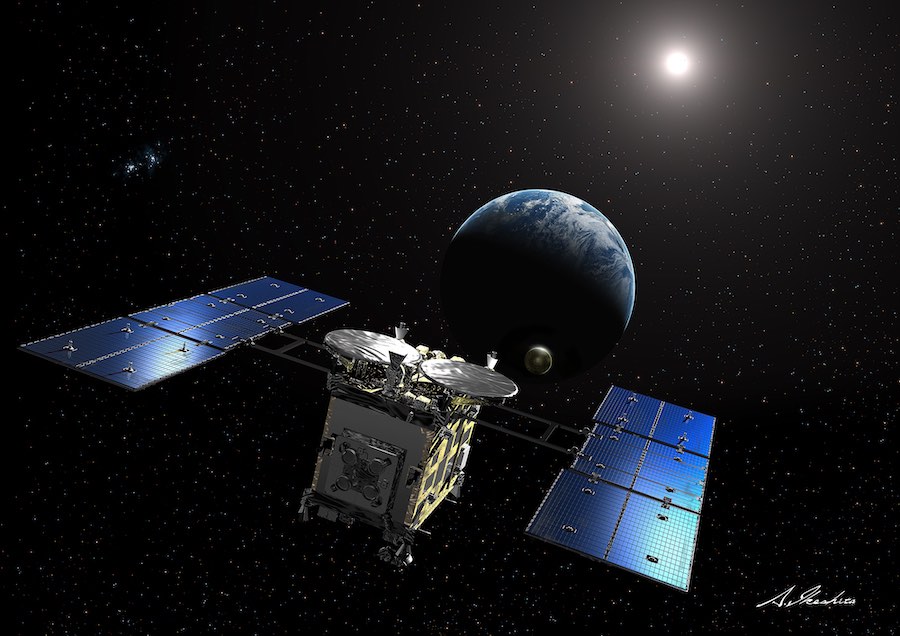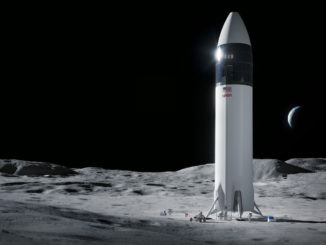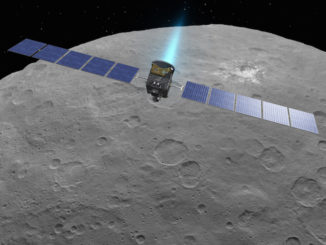
Six years after departing Earth, Japan’s Hayabusa 2 spacecraft released a spinning capsule Saturday containing pristine asteroid material for a scorching re-entry and landing in the remote Australian outback, where teams are standing by to retrieve the specimens for analysis.
The robotic asteroid explorer spring-ejected the nearly 16-inch (40-centimeter) diameter sample return carrier at 12:30 a.m. EST (0530 GMT) after placing the capsule on a precise course toward the recovery zone in South Australia.
The separation spring system was expected to impart a spin to the capsule to stabilize the craft during the rest of its journey toward Earth.
Engineers at the Japan Aerospace Exploration Agency control center confirmed the return capsule separation as Hayabusa 2 closed in on Earth at a range of about 136,000 miles, or 220,000 kilometers.
The return capsule was expected to close that distance in 12 hours, culminating in a plunge into Earth’s atmosphere at 12:28 p.m. EST (1728 GMT). Protected by a carbon heat shield, the outside of the sample carrier will encounter temperatures of around 5,400 degrees Fahrenheit (3,000 degrees Celsius).
The capsule will slow from a velocity of nearly 26,000 mph (11.6 kilometers per second) to about 6,700 mph (3 kilometers per second) in less than a minute.
A couple of minutes later, while traveling at about 220 mph (100 meters per second), the capsule will jettison its heat shield and deploy a parachute at an altitude of around 33,000 feet (10 kilometers), beginning a gentle descent toward Hayabusa 2’s recovery zone in the Woomera Prohibited Area of South Australia.
Touchdown is expected in a 10-minute window beginning at 12:47 p.m. EST (1247 GMT). The exact time is uncertain due to dispersions to the craft’s trajectory during descent.
Meanwhile the Hayabusa 2 spacecraft performed three divert maneuvers shortly after releasing the sample return capsule. The course correction steered Hayabusa 2 on a trajectory to pass a few hundred miles above Earth, allowing the spacecraft to observe the re-entry of the sample capsule before traveling back into deep space for an extended mission to visit two more asteroids in 2026 and 2031.
Japanese scientists, with the aid of Australian government officials, have been at Woomera for several weeks setting up tracking equipment, erecting antennas, and rehearsing their recovery procedures.
The Australian military, which oversees operations at the Woomera Range Complex in South Australia, is providing support and access to the Hayabusa 2 landing zone.
Japan’s first asteroid sample return mission, named Hayabusa, brought back microscopic specimens with a successful parachute-assisted landing at Woomera in June 2010. The Hayabusa mission suffered problems with its sample collection mechanism, limiting the quantity of asteroid material it could return to Earth.
Hayabusa 2 performed nearly flawlessly over its six-year mission, which began with launch from Japan in December 2014 aboard an H-2A rocket. The spacecraft reached Ryugu, a half-mile-wide (900-meter) asteroid that crosses Earth’s orbit, in June 2018 after a journey of three-and-a-half years.
The spacecraft dropped a fleet of landers and rovers to the explore the asteroid’s surface in late 2018, including a hopping robot developed by engineers in Germany and France.
Hayabusa 2 then approached Ryugu for two touch-and-go-landings in 2019 to gather rock fragments from two different locations. During one of the sample collection maneuvers, Hayabusa 2 descended into an artificial crater created by an explosive impactor released by the spacecraft, allowing the probe to gather material from the asteroid’s subsurface.
Scientists are eager to analyze the specimens, which they expect may contain organic molecules. Researchers believe asteroids like Ryugu, or a larger body like the one from which Ryugu split off, could have seeded Earth with materials necessary for life.
Hayabusa 2 departed Ryugu in November 2019 to begin the year-long trip back to Earth.
The probe used ion thrusters to reshape its trajectory through the solar system, and the ion propulsion system completed its job in September after guiding the spacecraft on a return course to Earth. Additional burns by the spacecraft’s conventional rocket thrusters fine-tuned its approach, targeting a recovery ellipse at Woomera stretching some 90 miles (150 kilometers) long and 60 miles (100 kilometers) wide.
Mission planners designed Hayabusa 2 to collect at least 100 milligrams of material from asteroid Ryugu. Engineers have no way of measuring the contents of the sample canister until it returns to Earth, but they are confident the spacecraft gathered the required material due to the near-perfect performance of the sampling system during the touch-and-go landing runs last year.
A recovery team in Australia will locate the Hayabusa 2 sample canister with the help of a radio beacon, then secure it for a flight to Sagamihara, Japan, where scientists will transfer the capsule into an ultra-clean curation facility. Researchers will open the canister and extract the asteroid specimens for analysis with sophisticated laboratory instruments.
Scientists hope the samples from Ryugu, which is covered in carbon-rich minerals, will shed light on the origins of the solar system more than 4.5 billion years ago, and provide hints on how water and the building blocks for life arrived on Earth.
Email the author.
Follow Stephen Clark on Twitter: @StephenClark1.



